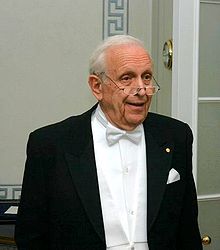Roy J. Glauber
- Roy J. Glauber
-

Pour les articles homonymes, voir
Glauber.
Roy J. Glauber (1er septembre 1925) est un physicien américain. Il est lauréat de la moitié du prix Nobel de physique de 2005[1].
Biographie
Il a obtenu son diplôme en physique d'un High school du Bronx en 1941. Il a ensuite travaillé au Projet Manhattan. En 1963, il publie la plupart des textes importants sur les notions et les mathématiques qui sous-tendent la cohérence optique.
Il est lauréat de la moitié du prix Nobel de physique en 2005 (l'autre moitié a été remise à Theodor W. Hänsch et à John L. Hall) « pour sa contribution à la théorie quantique de la cohérence optique[1] ».
En 2010, il est professeur à l'Université Harvard.
Notes et références
Voir aussi
Article connexe
Liens externes
|
Lauréats du prix Nobel de physique |
| 1901–1925 |
|
| 1926–1950 |
|
| 1951–1975 |
Cockcroft, Walton (1951) • Bloch, Purcell (1952) • Zernike (1953) • Born, Bothe (1954) • Lamb, Kusch (1955) • Shockley, Bardeen, Brattain (1956) • Yang, T. D. Lee (1957) • Cherenkov, Frank, Tamm (1958) • Segrè, Chamberlain (1959) • Glaser (1960) • Hofstadter, Mössbauer (1961) • Landau (1962) • Wigner, Goeppert-Mayer, Jensen (1963) • Townes, Bassov, Prokhorov (1964) • Tomonaga, Schwinger, Feynman (1965) • Kastler (1966) • Bethe (1967) • Alvarez (1968) • Gell-Mann (1969) • Alfvén, Néel (1970) • Gabor (1971) • Bardeen, Cooper, Schrieffer (1972) • Esaki, Giaever, Josephson (1973) • Ryle, Hewish (1974) • A. Bohr, Mottelson, Rainwater (1975)
|
| 1976–2000 |
Richter, Ting (1976) • P. W. Anderson, Mott, Van Vleck (1977) • Kapitsa, Penzias, R. Wilson (1978) • Glashow, Salam, Weinberg (1979) • Cronin, Fitch (1980) • Bloembergen, Schawlow, K. Siegbahn (1981) • K. Wilson (1982) • Chandrasekhar, Fowler (1983) • Rubbia, van der Meer (1984) • von Klitzing (1985) • Ruska, Binnig, Rohrer (1986) • Bednorz, Müller (1987) • Lederman, Schwartz, Steinberger (1988) • Ramsey, Dehmelt, Paul (1989) • Friedman, Kendall, R. Taylor (1990) • de Gennes (1991) • Charpak (1992) • Hulse, J. Taylor (1993) • Brockhouse, Shull (1994) • Perl, Reines (1995) • D. Lee, Osheroff, R. Richardson (1996) • Chu, Cohen-Tannoudji, Phillips (1997) • Laughlin, Störmer, Tsui (1998) • 't Hooft, Veltman (1999) • Alferov, Kroemer, Kilby (2000)
|
| 2001–aujourd'hui |
Cornell, Ketterle, Wieman (2001) • Davis, Koshiba, Giacconi (2002) • Abrikosov, Ginzburg, Leggett (2003) • Gross, Politzer, Wilczek (2004) • Glauber, Hall, Hänsch (2005) • Mather, Smoot (2006) • Fert, Grünberg (2007) • Nambu, Kobayashi, Maskawa (2008) • Kao, Boyle, Smith (2009) • Geim, Novoselov (2010)
|
| Prix Nobel • Chimie • Littérature • Paix • Économie • Physique • Physiologie ou médecine |
Catégories :
- Physicien américain
- Lauréat du prix Nobel de physique
- Lauréat américain du prix Nobel
- Naissance en 1925
- Docteur de l'université Harvard
Wikimedia Foundation.
2010.
Contenu soumis à la licence CC-BY-SA. Source : Article Roy J. Glauber de Wikipédia en français (auteurs)
Regardez d'autres dictionnaires:
Roy J. Glauber — Saltar a navegación, búsqueda Roy J. Glauber en la entrega del Premio Nobel de 2005. Roy J. Glauber (nacido en 1925) es profesor de física de la Universidad de Harvard. Fue galardonado junto con John L. Hall y Theodor W. Hänsch con el Premio … Wikipedia Español
Roy J. Glauber — Roy Jay Glauber bei der Nobelpreisverleihung Roy Jay Glauber (* 1. September 1925 in New York, NY, USA) ist ein US amerikanischer Physiker. Er ist Mallinckrodt Professor of Physics an der Harvard Universität und erhielt 2005 den Nobelpreis für… … Deutsch Wikipedia
Roy J. Glauber — (nacido en 1925) es profesor de física de la Universidad de Harvard. Fue galardonado junto con John L. Hall y Theodor W. Hänsch con el Premio Nobel de Física del año 2005 por su contribución a la teoría cuántica de coherencia óptica. En sus… … Enciclopedia Universal
Roy J. Glauber — Infobox Scientist name = Roy J. Glauber imagesize = 200px birth date = Birth date and age|1925|9|1|df=yes birth place = New York City, New York, USA residence = United States nationality = United States field = Physics work institution = Harvard… … Wikipedia
Roy Glauber — Roy Jay Glauber bei der Nobelpreisverleihung Roy Jay Glauber (* 1. September 1925 in New York, NY, USA) ist ein US amerikanischer Physiker. Er ist Mallinckrodt Professor of Physics an der Harvard Universität und erhielt 2005 den Nobelpreis für… … Deutsch Wikipedia
Roy Glauber — Roy J. Glauber Roy J. Glauber (né le 1er septembre 1925) est un physicien américain qui a obtenu le prix Nobel de physique en 2005 pour sa description théorique du comportement des particules de lumière. Il partage ce prix avec Theodor W.… … Wikipédia en Français
Glauber (disambiguation) — Glauber can mean:* Glauber, a computer software system * Glauber (crater)Glauber can refer to the following people: * Gláuber (footballer), Brazilian footballer * Roy J. Glauber, American physicist * Johann Rudolf Glauber, Dutch German alchemist… … Wikipedia
Glauber — ist der Familienname folgender Personen: Hans Glauber (1933–2008), südtiroler Künstler, Soziologe und Bergsteiger Honorato Gláuber (* 1983), brasilianischer Fußballspieler Johann Rudolph Glauber (1604–1670), deutscher Apotheker und Chemiker… … Deutsch Wikipedia
Glauber-Zustand — Kohärente Zustände (vgl. auch kohärente Strahlung) sind quantenmechanische Zustände unbestimmter Teilchenzahl, meist bei Bosonen. Wie R.J. Glauber 1963 zeigte, lässt sich die elektromagnetische Welle einer Laser Mode am besten durch kohärente… … Deutsch Wikipedia
Glauber-Sudarshan P-representation — The Glauber Sudarshan P representation is a way of writing down the state of any type of light using the coherent states as a basis. It was developed by George Sudarshan and later adopted by Roy J. Glauber (see the references below). It was the… … Wikipedia
 Pour les articles homonymes, voir Glauber.
Pour les articles homonymes, voir Glauber.
